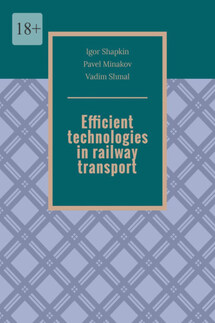Efficient technologies in railway transport - страница 7
Improving the efficiency of marshalling yards is also one of the most important areas of the first block of measures.
Thus, in order to increase their processing capacity, in particular by eliminating recycling, it is proposed to form a program for the development of auxiliary – pre-node stations with the transfer of processing of local car traffic to them. To improve the efficiency of the port stations, it is proposed to form a comprehensive program for the development of the infrastructure of railway port stations and port infrastructure.
The second vector is the development and implementation of information technologies and modern technical means.
This is one of the most important sections of the Program, since at present it is the development of information technologies that directly affects the quality of the transportation process, from making operational decisions on the organization of transportation activities to providing an appropriate analytical base.
One of the priority tasks in the development of automated control systems for the transportation complex is the transition from information systems to information management systems. The implementation of the stated principles laid the foundation for a new project – an intelligent railway transport management system. The system under development provides:
– automation of the forecast of the use of network resources, with the coordination of throughput and processing capacities, as well as the technology of planning and management of traction resources, the development of technical standards of operational work;
– mutual linking of fully functional automated workplaces of employees of the Central Directorate;
– the transition from solving disparate tasks to interrelated calculations of the formation plan and train schedule, taking into account specific technologies.
That is, the whole complex of technologies for managing the transportation process.
The automated system for organizing the movement of trains on the high-speed Moscow-St. Petersburg route is already solving the tasks of monitoring compliance with the technology of passing high-speed SAPSAN trains. The successful experience of operating the automated train control system “ACS-D” during the Winter Olympic Games has shown the possibilities of solving problems of automation of dispatching control of train traffic and route preparation. During the Olympic and Paralympic Games, the train schedule exceeded 99% with an average daily circulation of more than 200 pairs of trains.
In the future, it is proposed to gradually introduce this system at all operating sites equipped with dispatching centralization, and with modernization and new construction, this requirement is now laid down in the technical conditions.
The largest port station Luzhskaya is implementing the most modern technologies and technical means, most of which will be implemented for the first time on Russian railways.
This is a dissolution management system that allows organizing the sorting process for one person (the person on duty on the hill), pulling up the cars in the sorting fleet, managing the locomotive without the participation of the driver, a special automated mode for the dissolution of wagons with dangerous goods, electronic document management.
The draft Program assumes the implementation of measures aimed at excluding a person from the process of securing rolling stock, inspecting trains, both commercially and technically.









